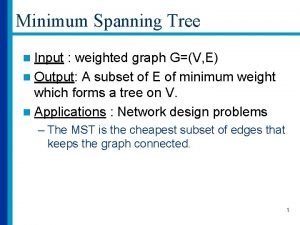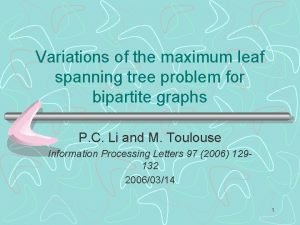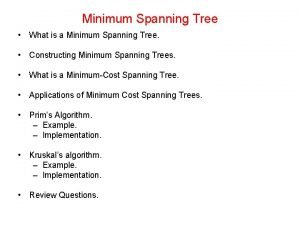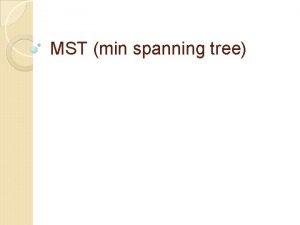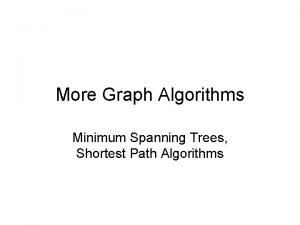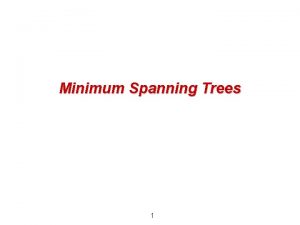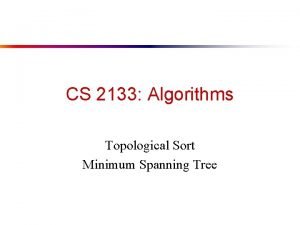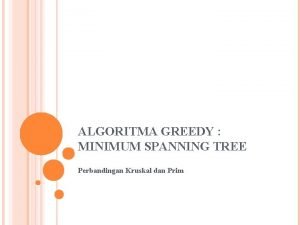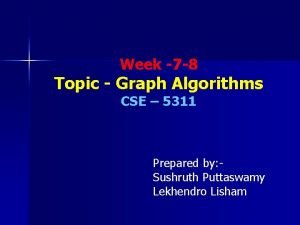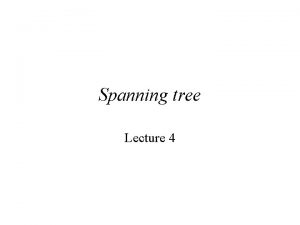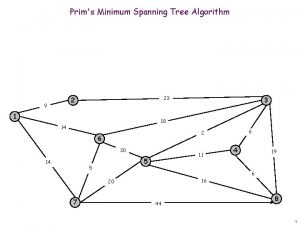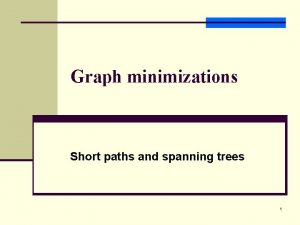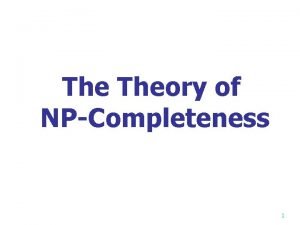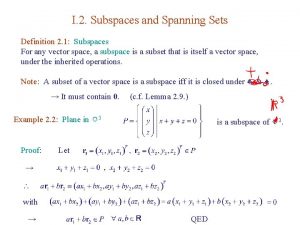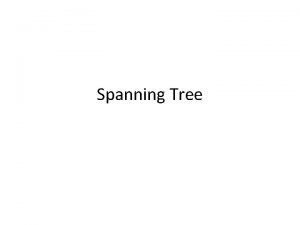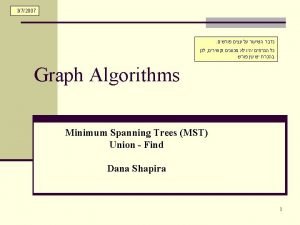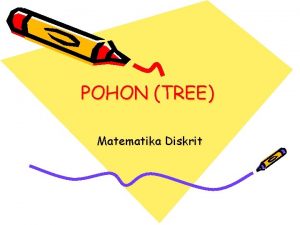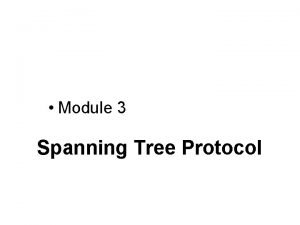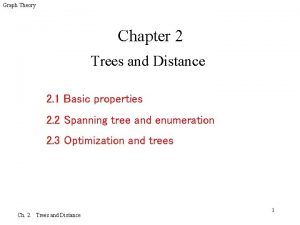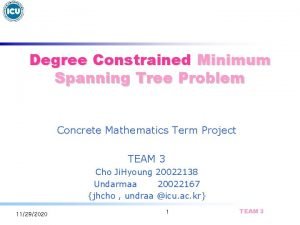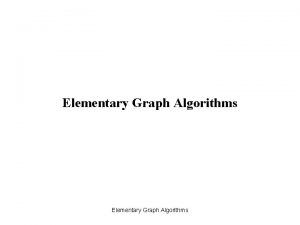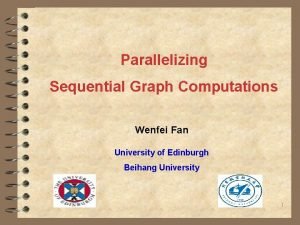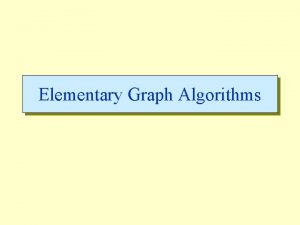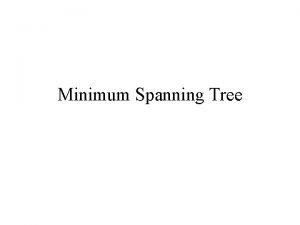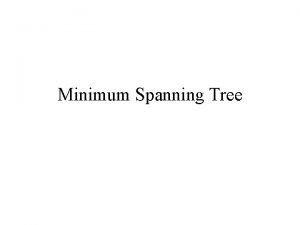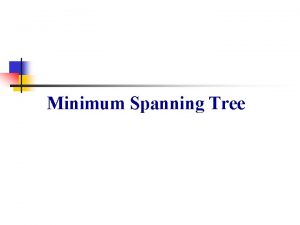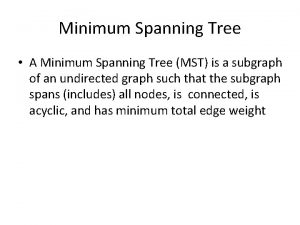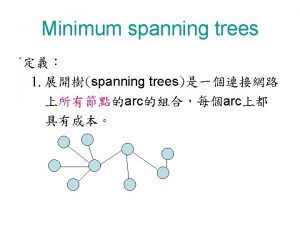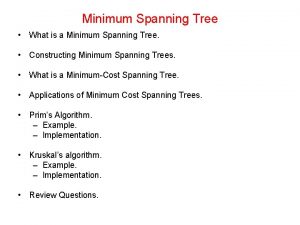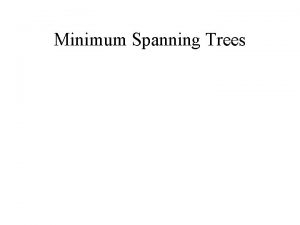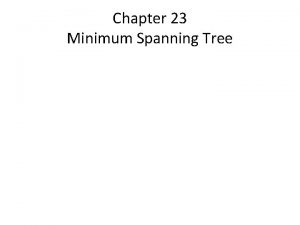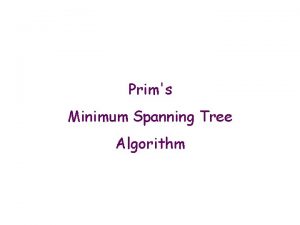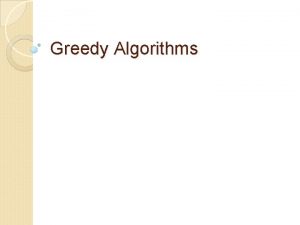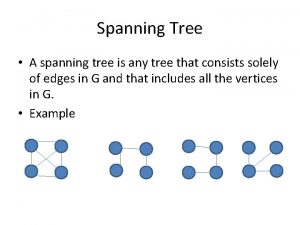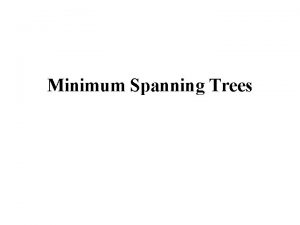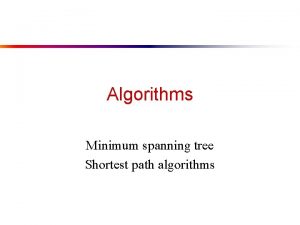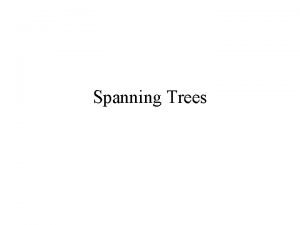Graph Algorithms Minimum Spanning Tree Spanning Tree A





















![Prim’s Algorithm l key[u]: the cost to enter spanning tree set π[u]: the vertex Prim’s Algorithm l key[u]: the cost to enter spanning tree set π[u]: the vertex](https://slidetodoc.com/presentation_image_h2/99fe968beec2e46c2d14e23c0b6fa0a3/image-22.jpg)












- Slides: 34

Graph Algorithms Minimum Spanning Tree

Spanning Tree Ø A tree (T ) is said to span G = (V, E) if T = (V, E’) and E’ E G Ø There are usually several possible spanning trees V 1 V 2 V 3 V 6 V 4 Two example Spanning Trees of G V 2 V 3 V 5 V 3 V 6 V 1 V 6 V 4 V 5 2

Minimum Spanning Tree A Minimum Spanning Tree (MST) is a spanning tree of G whose sum of edge weights is minimized 1 24 2 4 23 6 16 3 6 14 10 7 11 5 8 9 18 5 21 1 3 2 4 9 6 6 4 8 7 G = (V, E) 5 5 11 4 7 8 T = (V, F) w(T) = 50 Cayley's Theorem (1889) There are nn-2 spanning trees of a complete graph Gn Ø n = |V |, m = |E | Ø Can't solve MST by brute force (because of nn-2) 3

Constructing a Minimum Spanning Tree Ø Properties of an MST Ø |V|-1 Edges Ø No Cycles Ø Might not be Unique Ø Constructing an MST Ø Defined as a set of Edges A Ø Initially A has no Edges Ø Iteratively add SAFE Edges to A until MST is constructed 4

Safe Edges l 5

Generic MST Algorithm 6

Some Definitions l 7

Some Definitions l Light edge 8

Theorem Let A be a subset of some MST, (S, V-S) be a cut that respects A, and (u, v) be a light edge crossing (S, V-S) Then (u, v) is safe for A Edge No Loops Light Satisfies the minimum cost objective of MST 9

Two Algorithms to be Considered Greedy Algorithms Ø Kruskal’s Algorithm, Ø Prim’s Algorithm 10

MST Computation Kruskal’s Algorithm Ø Sort edges in increasing order of weight Ø Select edges e E in sequence from the sorted list Ø Continue to add the edge e to A such that it does not form a cycle Ø Edges are added to A until |A| = |V|-1 11

Kruskal Algorithm Ø Ø Ø Create-Set(u): Creates a set containing u with a unique set identifier Find-Set(u): Returns the identifier of the set that contains u Union(u, v): Merges the sets containing u and v. All elements of the merged set will have the same identifier 12

Kruskal’s Algorithm (Example) V 2 identifier vertex name 3 V 2 V 3 V 1 1 3 V 1 2 4 1 V 5 V 6 V 1 V 1 V 2 V 3 After the iteration V 3 V 4 1 V 5 V 1 V 6 V 3 V 1 1 V 3 V 4 After the 4 th iteration 1 V 5 V 3 3 V 2 V 3 V 1 1 V 4 V 3 After the 3 rd iteration 2 V 1 V 3 V 1 1 V 3 V 5 V 2 V 1 1 2 1 1 st 1 2 nd V 3 1 V 3 V 2 1 V 1 After the iteration V 1 4 V 5 1 V 6 V 1 V 2 1 V 6 V 1 V 5 V 1 After the 5 th iteration

Kruskal’s Algorithm (Example) V 2 identifier vertex name 3 V 2 V 3 1 V 1 2 3 V 1 4 V 4 1 1 V 4 V 5 V 6 V 1 V 2 V 6 V 5 V 3 1 V 1 V 3 V 4 1 1 st V 1 1 V 5 V 2 V 3 V 4 V 3 After the 4 th iteration 1 1 V 5 V 3 3 V 2 V 3 V 1 2 V 1 1 Sets V 1 {V 1, V 2, V 3, V 4, V 5, V 6} V 1 V 4 V 3 After the 3 rd iteration V 1 1 V 6 V 3 Sets V 1 {V 1, V 2} V 3 {V 3, V 4, V 5} V 1 1 2 nd V 1 V 3 V 5 Sets V 1 {V 1, V 2} V 3 {V 3, V 5} After the iteration 2 1 V 3 V 2 V 3 1 Sets V 1 {V 1, V 2} V 3 {V 3, V 4, V 5, V 6} After the iteration V 1 V 1 V 2 1 V 1 4 Sets Identifier {Vertices} V 1 Sets V 1 {V 1, V 2} 1 V 6 V 1 V 5 V 1 After the 5 th iteration

Kruskal Algorithm Analysis Ø Lines 1 -3 (Initialization): O(V) 15

Kruskal Algorithm Analysis l 16

Kruskal Algorithm Analysis l 17

Kruskal Algorithm Analysis l 18

Kruskal Algorithm Analysis l 19

Kruskal Algorithm Analysis l 20

MST Computation Prim’s Algorithm: Ø Select an arbitrary node as the initial tree (T) Ø Augment T in an iterative fashion by adding the outgoing edge (u, v), (i. e. , u T and v G-T ) with minimum cost (i. e. , light edge) Ø The algorithm stops after |V| - 1 iterations 21
![Prims Algorithm l keyu the cost to enter spanning tree set πu the vertex Prim’s Algorithm l key[u]: the cost to enter spanning tree set π[u]: the vertex](https://slidetodoc.com/presentation_image_h2/99fe968beec2e46c2d14e23c0b6fa0a3/image-22.jpg)
Prim’s Algorithm l key[u]: the cost to enter spanning tree set π[u]: the vertex through which u can be added to the spanning tree set 22

Prim’s Algorithm l Make cost of the root = 0 23

Prim’s Algorithm l Add all vertices to a queue Q such that r (root) is at the head of the list 24

Prim’s Algorithm l Extract the vertex at the head of the queue 25

Prim’s Algorithm l For each adjacent vertex check if it is has been added or not to the spanning tree (still in Queue? ) If it has not been added to the spanning tree, update the cost of entering the spanning tree set 26

Prim’s Algorithm l Update position of v in Q such that it remains sorted 27

Prim’s Algorithm (Example) V 2 3 V 3 1 3 V 1 2 1 V 2 Algorithm starts V 6 1 V 4 3 4 V 5 V 3 1 1 V 1 After the 1 st iteration V 2 3 V 3 After the 3 rd iteration V 3 2 1 V 5 3 1 1 V 1 After the 2 nd iteration V 2 1 3 V 4 1 V 1 1 V 5 After the 4 th iteration V 3 3 V 2 1 4 V 2 V 1 V 4 1 After the 5 th iteration V 6 V 5

Prim’s Algorithm (Example) Q keys V 2 3 V 3 1 3 V 1 1 V 4 2 1 3 1 V 1 3 {V 3, V 5, V 4, V 6} {3, 3, 4 , ∞} V 3 iteration V 5 3 {V 5, V 6, V 4} {1, 2, 4} V 3 1 1 2 1 V 1 {V 4, V 6} {1, 2} Q keys V 2 1 V 1 After the 2 nd iteration After the 1 st iteration V 2 Q keys 1 V 4 After the V 5 4 th 1 V 1 {V 6} {2} iteration V 3 3 V 2 Q keys V 3 3 After the V 6 4 V 5 1 3 rd V 2 Algorithm starts {V 1, V 2, V 3, V 4, V 5, V 6} {0, ∞ , ∞ , ∞} V 2 Q keys V 1 1 4 Q keys {V 2, V 4, V 3, V 5, V 6} {1 , 4, ∞ , ∞} V 4 After the 5 th 1 iteration V 6 V 5 Q keys {} {}

Analysis of Prim’s Algorithm l O(|V|) 30

Analysis of Prim’s Algorithm l Loop O(|V|) 31

Analysis of Prim’s Algorithm l O(|V|) Loop O(|V|) O(1) Total 2|E| Edges 32

Analysis of Prim’s Algorithm l Loop O(|V|) O(1) Total 2|E| Edges O(1) O(lg(|V|)) Binary search 33

Analysis of Prim’s Algorithm l Loop O(|V|) O(1) Total 2|E| Edges O(1) O(lg(|V|)) 34
 Minimum spanning tree weighted graph
Minimum spanning tree weighted graph Minimum leaf spanning tree
Minimum leaf spanning tree Minimum cost spanning tree
Minimum cost spanning tree Dijkstra spanning tree
Dijkstra spanning tree Minimum spanning tree 알고리즘
Minimum spanning tree 알고리즘 Minimum spanning tree definition
Minimum spanning tree definition Minimum spanning tree shortest path
Minimum spanning tree shortest path Minimum spanning tree
Minimum spanning tree Minimum spanning tree
Minimum spanning tree Contoh algoritma kruskal
Contoh algoritma kruskal Minimum spanning tree
Minimum spanning tree Minimum spanning tree
Minimum spanning tree Prims
Prims Minimum spanning tree
Minimum spanning tree Spanning tree of a graph
Spanning tree of a graph Spanning tree of a graph
Spanning tree of a graph Minimum spanning set
Minimum spanning set Absolute maximum and minimum
Absolute maximum and minimum Common spanning tree
Common spanning tree Spanning tree definition
Spanning tree definition Spanning tree
Spanning tree Misalkan t sebuah pohon dengan 50 buah sisi
Misalkan t sebuah pohon dengan 50 buah sisi Brily
Brily Udld normal vs aggressive
Udld normal vs aggressive Spanning tree algorithm in computer networks
Spanning tree algorithm in computer networks Adalah
Adalah Petr lapukhov
Petr lapukhov Spanning tree
Spanning tree Spanning tree tutorial
Spanning tree tutorial What is a subgraph in graph theory
What is a subgraph in graph theory Degree constrained spanning tree
Degree constrained spanning tree Asus spanning tree protocol
Asus spanning tree protocol White path theorem
White path theorem Parallelizing sequential graph computations
Parallelizing sequential graph computations Elementary graph algorithms
Elementary graph algorithms
